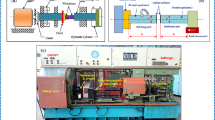Abstract
High strength, quench and tempered (Q&T) plates having yield strength of a minimum of 670 MPa and conforming to SA 517 Gr. F specification were successfully developed at Rourkela Steel Plant in plates up to 40 mm thickness. The plates are used extensively for the fabrication of impellers, penstocks, excavators, dumpers, and raw material handling devices, where welding is an important processing step. SA 517 Gr. F plates, characterized by a relatively high carbon equivalent (CE: ∼0.6) and alloyed with Ni, Cr, Mo, Cu, and V, are susceptible to a crack-sensitive microstructure and cold cracking during welding. In view of the above, the present study investigated the weldability properties of 20 mm thick plates using the shielded metal arc welding (SMAW) process. Implant and elastic restraint cracking (ERC) tests were carried out to assess the cold cracking resistance of the weld joint under different welding conditions. Preheat of 100 °C, partial or full rebake, and a heat input of 14.9 to 15.4 KJ/cm resulted in static fatigue limit (SFL) values well in excess of the minimum specified yield strength (MSYS) of 670 MPa and a critical restraint intensity (K cr) value of 34,650 MPa, indicating adequate cold cracking resistance. Lamellar tear tests conducted using full thickness plates at heat input levels ranging from 9.7 to 14.4 KJ/cm and weld restraint loads (WRL) of 510 to 685 MPa showed no incidence of lamellar tear upon visual, ultrasonic, and four-section macroexamination. The weld joint, based on optimized welding parameters, exhibited adequate tensile strength (812.4 MPa) and low temperature impact toughness 88.3 and 63.4 J (9.2 and 6.6 kg-m) at −40 °C for weld metal (WM), and heat-affected zone (HAZ) properties, respectively. The crack tip opening displacement (CTOD) values of WM and HAZ (0.40 and 0.36 mm, respectively) were superior to that of the parent metal (0.29 mm), indicating adequate resistance of weld joint to brittle fracture. It was concluded that the weld joint conforms to the requirements of SA 517 Gr. F specification and ensures a high integrity of the fabricated products.
Similar content being viewed by others
References
A.R. Marder: “Heat Treated Alloy Steels,” in Encyclopedia of Material Science and Engineering, M.B. Bever, ed., Pergamon Press, vol. 3, Elmsford, NY, 1986, p. 211.
F.N. William: Welding J., 1995, 74, p. 57.
B.A. Graville: Proceedings of the International Conference on Welding of HSLA Structural Steels, A.B. Rothwell and J.M. Gray, ed., ASM, Metals Park, OH, 1978, p. 85.
International Institute of Welding (IIW) document no. 830–873, 1993.
R. Veeraraghavan, V.P. Raghupathy, G. Venkataraman, R.S. Babu, and K.S. Raman: Proceedings of the Workshop of Steel for Engineering Industries—Trends in Weldability (TWS-98), IIM, Trichy, India, 1998, pp. 147–59.
R. Datta, S. Mishra, J. Singh, V. Kumar, and S. Kumar: Steel Technol. Int., 1994–95, pp. 109–12.
S. Myoshi: Proceedings of Continuous Casting of Steel, The Metal Society/IRSID, 1976, pp. 286–91.
C.J. Van Vuuren: Steelmaking Proceedings, Iron & Steel Society, Warrendale, 1978, vol. 61, pp. 306–34.
Author information
Authors and Affiliations
Rights and permissions
About this article
Cite this article
Datta, R., Mukerjee, D., Jha, S. et al. Weldability characteristics of shielded metal arc welded high strength quenched and tempered plates. J. of Materi Eng and Perform 11, 5–10 (2002). https://doi.org/10.1007/s11665-002-0001-7
Received:
Revised:
Published:
Issue Date:
DOI: https://doi.org/10.1007/s11665-002-0001-7




